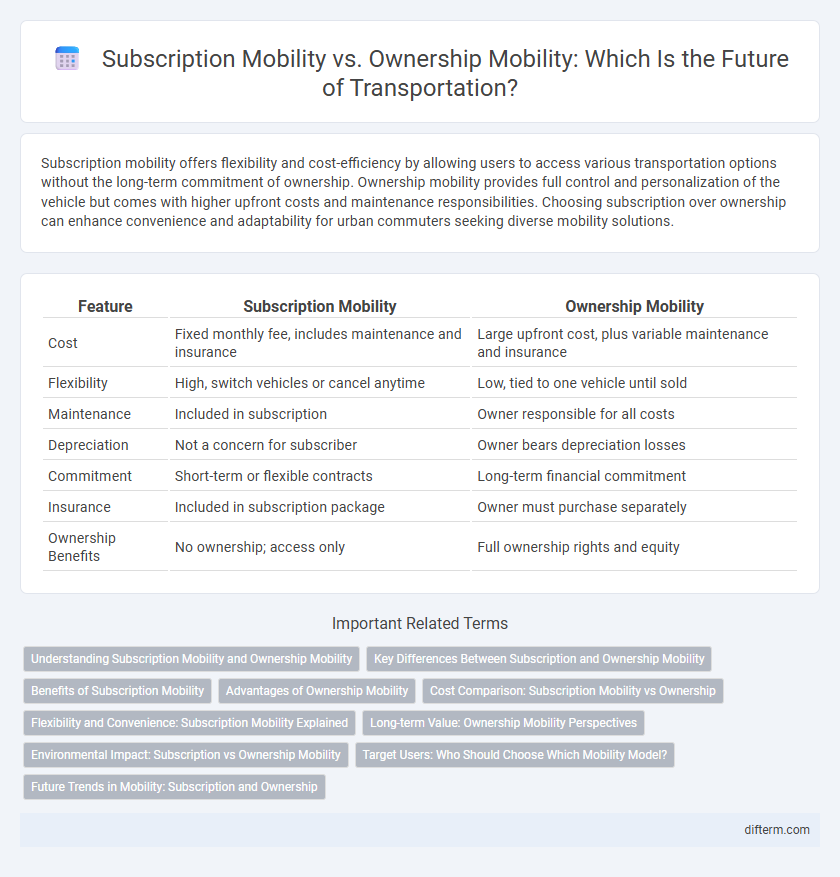Subscription mobility offers flexibility and cost-efficiency by allowing users to access various transportation options without the long-term commitment of ownership. Ownership mobility provides full control and personalization of the vehicle but comes with higher upfront costs and maintenance responsibilities. Choosing subscription over ownership can enhance convenience and adaptability for urban commuters seeking diverse mobility solutions.
Table of Comparison
| Feature | Subscription Mobility | Ownership Mobility |
|---|---|---|
| Cost | Fixed monthly fee, includes maintenance and insurance | Large upfront cost, plus variable maintenance and insurance |
| Flexibility | High, switch vehicles or cancel anytime | Low, tied to one vehicle until sold |
| Maintenance | Included in subscription | Owner responsible for all costs |
| Depreciation | Not a concern for subscriber | Owner bears depreciation losses |
| Commitment | Short-term or flexible contracts | Long-term financial commitment |
| Insurance | Included in subscription package | Owner must purchase separately |
| Ownership Benefits | No ownership; access only | Full ownership rights and equity |
Understanding Subscription Mobility and Ownership Mobility
Subscription mobility offers flexible access to various vehicles without long-term commitments, enabling users to switch models based on needs and preferences. Ownership mobility provides full control and unlimited usage but involves upfront costs, maintenance responsibilities, and depreciation risk. Understanding these models helps consumers choose between convenience and investment in personalized transportation solutions.
Key Differences Between Subscription and Ownership Mobility
Subscription mobility offers flexible access to various transportation modes without long-term commitments, contrasting with ownership mobility, which involves full control and responsibility over a personal vehicle. Subscription models reduce upfront costs and maintenance burdens, enabling users to switch vehicles based on needs, while ownership provides convenience, customization, and potential long-term value retention. Key differences include cost structure, vehicle access flexibility, user responsibility, and overall convenience tailored to lifestyle and usage frequency.
Benefits of Subscription Mobility
Subscription mobility offers flexible access to a variety of vehicles without the long-term financial commitment of ownership, enabling users to adapt to changing transportation needs effortlessly. It reduces maintenance costs and depreciation risks, since service providers handle vehicle upkeep and upgrades. This model promotes sustainable urban mobility by encouraging shared use and reducing the total number of vehicles on the road.
Advantages of Ownership Mobility
Ownership mobility offers full control over vehicles, allowing unlimited use without recurring subscription fees, which leads to long-term cost savings. It provides the freedom to customize and maintain the vehicle according to personal preferences, enhancing user experience. Ownership also ensures availability at any time, eliminating dependency on third-party service schedules or availability constraints.
Cost Comparison: Subscription Mobility vs Ownership
Subscription mobility offers a predictable monthly fee that often includes maintenance, insurance, and roadside assistance, reducing unexpected expenses compared to ownership. Ownership mobility requires upfront costs such as down payments, depreciation, insurance, and maintenance, which can lead to higher long-term expenses. Analyzing total cost of ownership (TCO) reveals that subscriptions can be more cost-efficient for short-term or flexible usage, while ownership may be economical for extended, consistent use.
Flexibility and Convenience: Subscription Mobility Explained
Subscription mobility offers unmatched flexibility by allowing users to switch between different vehicle types and models without long-term commitments, adapting seamlessly to changing needs or preferences. Convenience is enhanced through bundled services like insurance, maintenance, and roadside assistance, eliminating the hassles associated with ownership. This model caters to urban dwellers and frequent travelers seeking cost-effective, adaptable, and stress-free transportation solutions.
Long-term Value: Ownership Mobility Perspectives
Ownership mobility creates long-term value by providing asset control and equity accumulation, which subscription models often lack. Consumers investing in vehicles build ownership structure benefits such as resale value, customization, and tax incentives, enhancing financial returns over time. This contrasts with subscription mobility that prioritizes flexibility but does not generate lasting property value or investment growth.
Environmental Impact: Subscription vs Ownership Mobility
Subscription mobility significantly reduces environmental impact by promoting shared vehicle use, which decreases the total number of cars on the road and lowers greenhouse gas emissions. Ownership mobility often leads to higher carbon footprints due to increased vehicle production, maintenance, and personal usage patterns. Studies show that subscription services can cut emissions by up to 30% compared to individual ownership through optimized fleet management and increased reliance on electric vehicles.
Target Users: Who Should Choose Which Mobility Model?
Subscription mobility suits urban professionals and frequent travelers seeking flexibility, cost predictability, and access to diverse vehicle options without long-term commitments. Ownership mobility benefits individuals who prioritize vehicle customization, long-term cost savings, and consistent availability for daily commutes or family use. Businesses with fluctuating mobility needs or short-term projects may also prefer subscription models for scalability and convenience.
Future Trends in Mobility: Subscription and Ownership
Future trends in mobility indicate a significant shift from traditional vehicle ownership to subscription-based mobility services, driven by urbanization, technological advancements, and changing consumer preferences. Subscription mobility offers flexibility, cost efficiency, and access to diverse vehicle options without long-term commitments, appealing to younger, tech-savvy populations. Ownership mobility still holds value for those prioritizing control and asset accumulation, but the market is increasingly embracing hybrid models combining ownership benefits with subscription convenience.
subscription mobility vs ownership mobility Infographic

 difterm.com
difterm.com